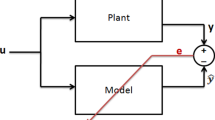Abstract
An adaptive supervised learning scheme is proposed in this paper for training Fuzzy Neural Networks (FNN) to identify discrete-time nonlinear dynamical systems. The FNN constructs are neural-network-based connectionist models consisting of several layers that are used to implement the functions of a fuzzy logic system. The fuzzy rule base considered here consists of Takagi-Sugeno IF-THEN rules, where the rule outputs are realized as linear polynomials of the input components. The FNN connectionist model is functionally partitioned into three separate parts, namely, the premise part, which provides the truth values of the rule preconditional statements, the consequent part providing the rule outputs, and the defuzzification part computing the final output of the FNN construct. The proposed learning scheme is a two-stage training algorithm that performs both structure and parameter learning, simultaneously. First, the structure learning task determines the proper fuzzy input partitions and the respective precondition matching, and is carried out by means of the rule base adaptation mechanism. The rule base adaptation mechanism is a self-organizing procedure which progressively generates the proper fuzzy rule base, during training, according to the operating conditions. Having completed the structure learning stage, the parameter learning is applied using the back-propagation algorithm, with the objective to adjust the premise/consequent parameters of the FNN so that the desired input/output representation is captured to an acceptable degree of accuracy. The structure/parameter training algorithm exhibits good learning and generalization capabilities as demonstrated via a series of simulation studies. Comparisons with conventional multilayer neural networks indicate the effectiveness of the proposed scheme.
Similar content being viewed by others
Explore related subjects
Discover the latest articles and news from researchers in related subjects, suggested using machine learning.References
Cybenko, G.: Approximation by superpositions of a sigmoidal function,Math. Control, Signals, and Systems (1989).
Hornik, K., Stinchcombe, M. and White, H.: Multilayer feedforward networks are universal approximators,Neural Networks 2, (1989), 359–366.
Narendra, K. S. and Parthasarathy, K.: Identification and control of dynamical systems using neural networks,IEEE Trans. Neural Networks 1 (1990), 4–27.
Narendra, K. S. and Parthasarathy, K.: Neural Networks and Dynamical Systems. Part I: Identification, Center for Syst. Sci., Dept. of Electrical Eng., Yale University, New Haven, CT, Tech. Rep. 8902, February 1989.
Narendra, K. S. and Parthasarathy, K.: Neural Networks and Dynamical Systems. Part II: Control, Center for Syst. Sci., Dept. of Electrical Eng., Yale University, New Haven, CT, Tech. Rep. 8909, May 1989.
Rumelhart, D. E. and McCleland, J. L. (eds),Parallel Distributed Processing I, II, MIT Press, Cambridge, MA, 1986.
Fukuda, T., Shibata, T. and Mitsuoka, T.: Adaptation and learning for robotic manipulator by neural network, inProc. 29th Conf. Decision and Control, Honolulu, Hawaii, 1990, pp. 3283–3288.
Fukuda, T. and Shibata, T.: Neural network applications for robotic motion control, inIEEE Int. Workshop Intelligent Motion Control, Istambul, Turkey, 1990, pp. 31–36.
Wang, S.-D. and Yeh, H. M. S., Self-adaptive neural architectures for control applications, inInt. Joint Conf. Neural Networks, Part III, 1990, pp. 309–314.
Guez, A. and Bar-Kana, I.: Two-degree-of-freedom robor neurocontroller, inProc. 29th Conf. Decision and Control, Honolulu, Hawaii, 1990, pp. 3260–3264.
Wang, Li-Xin:Adaptive Fuzzy Systems and Control: Design and Stability Analysis, PTR Prentice-Hall, Englewood Cliffs, NJ, 1994.
Lee, C. C.: Fuzzy logic in control systems: Fuzzy logic controller, Part I,IEEE Trans. Syst. Man and Cybernet SMC-20(2) (1990), 404–418.
Lee, C. C.: Fuzzy logic in control systems: Fuzzy logic controller, Part II,IEEE Trans. Syst. Man and Cybernet.SMC-20(2) (1990), 419–435.
Palm, Rainer: Fuzzy controller for sensor guided robot manipulators,Fuzzy Sets and Systems 31 (1989), 133–149.
Lim, C. M. and Hiyama, T.: Application of fuzzy logic control to a manipulator,IEEE Trans. Robotics and Automation 7(5) (1991), 688–691.
Zhou, J. and Coiffet, P.: Fuzzy control of robots, inInt. Conf. Fuzzy Systems, 1992, pp. 1357–1364.
Moudgal, V., Kwong, W. A., Passino, K. M. and Yurkovich, S.: Fuzzy learning control for a flexible-link robot,IEEE Trans. Fuzzy Systems 3(2) (1995), 199–210.
Rao, D. H. and Gupta, M. M.: Neuro-fuzzy controller for control and robotics applications,Eng. Appl. Artificial Intelligence 7(5) (1994), 479–491.
Fukuda, T., Shimojama, K. and Shibata, T.: Fuzzy, neural network and genetic algorithm based control system, inProc. 20th Int. Conf. Industrial Electronics, Control and Instrumentation, IECON'94, Vol. 2, 1994, pp. 1220–1225.
Wang, L. X. and Mendel, J. M.: Back-propagation fuzzy system as nonlinear dynamic system identifiers, inProc. IEEE Conf. Fuzzy Systems, 1992, pp. 1409–1418.
Nornura, H. J., Hayashi, I. and Wakami, N.: A learning method of fuzzy inference rules by descent method, inProc. IEEE Conf. Fuzzy Systems, 1992, pp. 203–210.
Horikawa, S. I., Furuhashi, T., Okuma, S. and Uckikawa, Y.:Composition Methods of Fuzzy Neural Networks, IECON, 1990.
Jang, J.-S. R.: ANFIS: Adaptive-network-based fuzzy inference system,IEEE Trans. Systems, Man, and Cybernet 23(3) (1993), 665–685.
Jang, J.-S. R.: Self learning fuzzy controllers based on temporal back propagation,IEEE Trans. Neural Networks 3(5) (1992), 714–723.
Lin, C. T. and Lee, C. S. G.: Real-time supervised structure/parameter learning for fuzzy neural network, inIEEE Conf. Fuzzy Systems, 1992, pp. 1283–1291.
Lin, C. T. and Lee, C. S. G.: Reinforcement structure/parameter learning for neural-network-based fuzzy logic control systems,IEEE Trans. Fuzzy Systems 2(1) (1995), 46–63.
Sugeno, M. and Kang, G.T.: Structure identification of fuzzy model,Fuzzy Sets and Systems 28 (1988), 15–33.
Ighibushi, H., Fujioka, R. and Tanaka, H.: An architecture of neural networks for input vectors of fuzzy numbers, inProc. IEEE Conf. Fuzzy Systems, 1992, pp. 1293–1300.
Takagi, T. and Sugeno, M.: Derivation of fuzzy control rules from human operator's control actions, inProc. IFAC Symp. Fuzzy Information, Knowledge Representation and Decision Analysis, July 1983, pp. 55–60.
Author information
Authors and Affiliations
Rights and permissions
About this article
Cite this article
Theocharis, J., Vachtsevanos, G. Adaptive Fuzzy Neural Networks as identifiers of discrete-time nonlinear dynamic systems. J Intell Robot Syst 17, 119–168 (1996). https://doi.org/10.1007/BF00776507
Received:
Accepted:
Issue Date:
DOI: https://doi.org/10.1007/BF00776507




